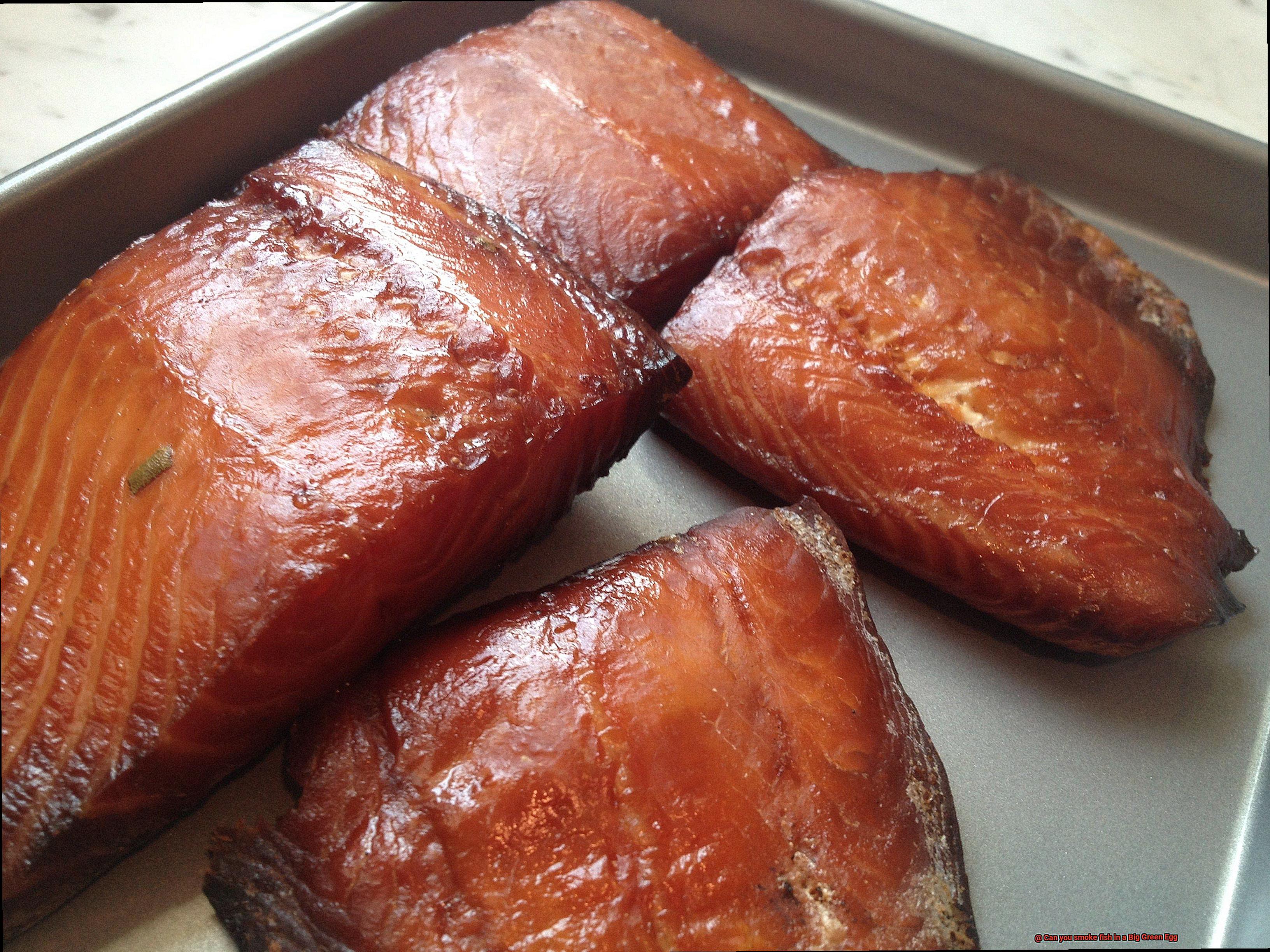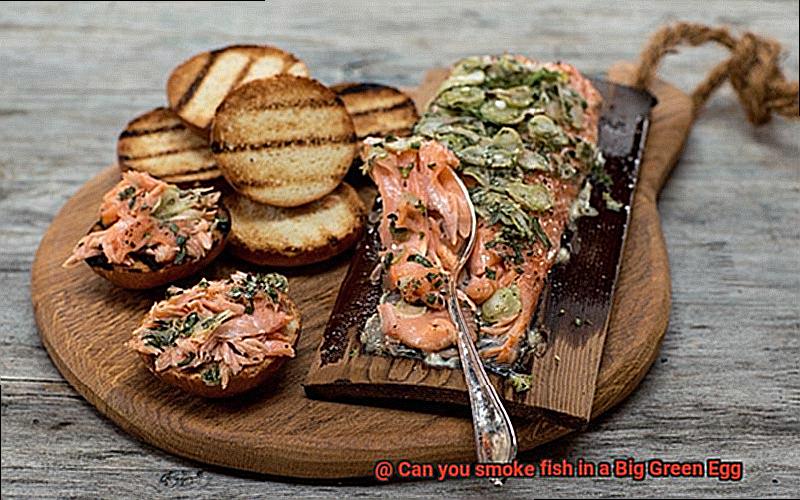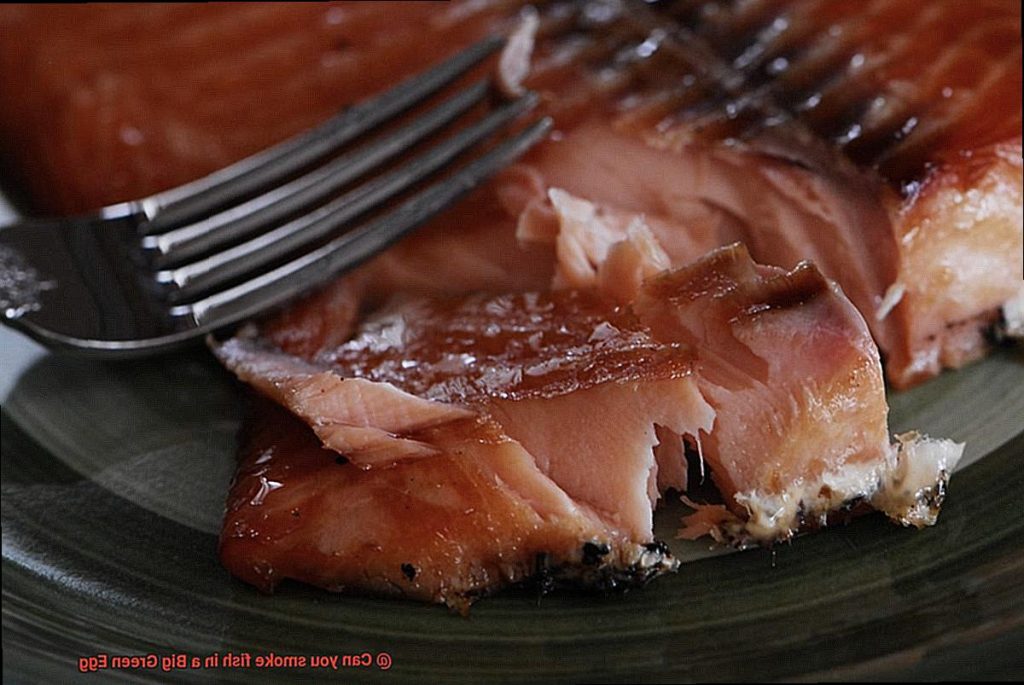Imagine a cool autumn night, the air thick with the intoxicating aroma of smoldering wood. And there, waiting to be devoured, are succulent fish fillets, perfectly kissed by smoke. If you’re a seafood lover and a grilling enthusiast, you’ve probably wondered if you can smoke fish in a Big Green Egg. Well, my friends, wonder no more – because it’s absolutely possible.
In this blog post, we’ll take a deep dive into the world of smoking fish in a Big Green Egg. We’ll explore the endless possibilities and impressive capabilities of this incredible ceramic grilling machine. And fear not. We’ll also share some expert tips and techniques to help you achieve that mouthwatering smoky flavor that will have everyone begging for seconds.

Whether you’re an experienced grill master or just starting your smoking journey, get ready to unlock a whole new level of culinary mastery with your trusty Big Green Egg. So grab your apron, gather your favorite seasonings, and join us on this delectable adventure through the enchanting realm of smoking fish in a Big Green Egg.
Prepare to ignite your senses and leave your loved ones clamoring for more of your irresistible smoked fish creations.
Contents
What is the Big Green Egg?
Look no further than the Big Green Egg. This versatile and innovative outdoor cooking device is not just a grill, but a smoker and oven all rolled into one. Its unique egg-shaped design, made from high-quality ceramic, ensures exceptional heat retention and distribution, allowing for precise temperature control and even cooking. Get ready to elevate your grilling game with the Big Green Egg.
Unleash Your Creativity:
The Big Green Egg offers endless possibilities when it comes to outdoor cooking. Whether you’re grilling steaks, smoking fish, baking pizzas, or even roasting a whole chicken, this culinary powerhouse has got you covered.
Its ability to reach and maintain high temperatures makes it perfect for searing steaks to perfection, while its exceptional heat retention allows for slow and low smoking sessions that result in tender and flavorful meats.
The Secret of Kamado Cooking:
The origins of the Big Green Egg can be traced back to ancient clay cooking vessels known as kamados. These traditional pots have been used in China and Japan for centuries for various cooking methods. The modern-day Big Green Egg draws inspiration from these ancient cooking techniques but incorporates innovative features and materials to enhance performance.
Size Options to Fit Your Needs:
The Big Green Egg comes in various sizes to suit different cooking needs. From small portable models perfect for camping or tailgating, to extra-large models capable of cooking for large gatherings, there is a size for everyone. Each size offers a different cooking capacity, ensuring that you can cook up a feast no matter the occasion.
Durability and Longevity:
The Big Green Egg’s ceramic construction is not just for show. It is designed to withstand high temperatures without cracking, ensuring durability and longevity. This means that your investment in the Big Green Egg will last for years to come, providing you with countless memorable meals and cooking experiences.
What Type of Fish Is Best for Smoking?
Step into the world of smoking fish in a Big Green Egg, but be warned – not all fish are created equal when it comes to this culinary adventure. To achieve the perfect balance of flavor, moisture, and texture, you must select the right type of fish.
So, let’s dive deep and uncover the best options for your Big Green Egg.
- Fatty fish: When it comes to smoking, fatty fish reign supreme. Their high oil content keeps the flesh moist and succulent throughout the smoking process. Salmon takes center stage with its rich flavor and firm texture. It holds up beautifully to low and slow smoking, resulting in a mouthwatering symphony of smoky goodness. If you’re feeling adventurous, consider mackerel or sardines – their strong and distinct flavors dance harmoniously with the smokiness.
- Whitefish: If you prefer a milder experience, venture into the realm of whitefish such as cod, haddock, and halibut. However, these delicate fish require a touch more finesse. Their subtle flavors can easily be overwhelmed if not monitored closely. But fear not. With proper attention, you can achieve tender and flaky smoked whitefish that will impress even the most discerning palates.
- Trout: Another stellar option for your Big Green Egg smoking escapades is trout. Its subtle yet distinct flavor pairs beautifully with the smokiness imparted by this versatile cooking device. The gentle heat of the Big Green Egg caresses its tender flesh, resulting in a truly delightful culinary experience that will have you coming back for more.
Remember, always choose fresh, high-quality fish for smoking. Seek out bright eyes, shiny skin, and a fresh aroma when selecting your catch of the day. And consider the size and thickness of the fish when planning your smoking session – thicker cuts may require longer cooking times to ensure they are fully cooked while maintaining their succulence.
Temperature Control for Smoking Fish in a Big Green Egg
Today, we embark on a culinary adventure to master the art of smoking fish in a Big Green Egg. Temperature control is the secret ingredient to success, ensuring your fish is cooked evenly, retains its delicate texture, and bursts with flavor.
Join us as we unlock the secrets to achieve perfect smoked fish every time.
The Ideal Smoking Temperature:
To achieve smokey perfection, aim for a temperature range between 225°F to 250°F (107°C to 121°C). This gentle heat allows flavors to develop while preserving the moisture in the fish.

Creating the Perfect Cooking Environment:
To prevent your fish from drying out during the smoking process, use indirect heat and a drip pan filled with water or other liquid. This combination creates a moist cooking environment that enhances flavor and maintains juiciness.
Adjusting the Dampers:
Regulate airflow and control temperature by adjusting the dampers. Partially open the bottom damper to ensure proper airflow, while adjusting the top damper according to your desired temperature.
Monitoring Temperature:
Maintain a watchful eye on the temperature throughout the smoking process using a reliable thermometer. This ensures your fish reaches a safe internal temperature of 145°F (63°C) while maintaining that desired smoky flavor.
Enhancing Flavor with Wood Chips:
Elevate your smoked fish experience by adding soaked wood chips or chunks, like hickory or applewood, to your charcoal. Soaking them in water for approximately 30 minutes before adding ensures they smolder rather than burn, imparting a rich and distinctive taste.
Smoking Time:
The smoking time can vary depending on factors such as the size and thickness of the fish fillets or whole fish. Generally, allow 1 to 3 hours for your fish to reach perfection. Remember to flip the fish halfway through for even cooking on both sides.
The Perfect Finish:
Once your fish reaches an internal temperature of 145°F (63°C) and flakes easily with a fork, it’s time to remove it from the Big Green Egg. Allow it to rest for a few minutes before serving to ensure maximum juiciness.
Preparing the Fish Before Smoking
Before you embark on the journey of indulging in the smoky goodness of perfectly cooked fish from a Big Green Egg, it is crucial to show your fish some love and attention during the preparation process. By following these simple steps, you will ensure that your fish is not only delicious but also bursting with flavor and succulence that will make your taste buds dance with joy.
First and foremost, selecting the right fish sets the foundation for a spectacular smoking experience. Opt for fresh fish that is ideal for smoking. Fatty fish like salmon, trout, and mackerel are popular choices due to their luscious texture and full-bodied flavor. These fishes possess the resilience to withstand the intense smoky flavors while retaining their moisture throughout the cooking process.
Once you have made your selection, it’s time to give your fish a thorough cleaning. Remove any scales, guts, and fins with precision, ensuring that no remnants remain. Rinse the fish under a stream of cold water, cleansing away any impurities that may hinder the purity of its flavors. Remember, cleanliness is paramount when it comes to smoking fish; it ensures that unwanted flavors do not infiltrate your culinary masterpiece.
After cleaning, gently pat the fish dry with paper towels. This step is of utmost importance as it eliminates excess moisture from the surface of the fish, allowing it to absorb the rich flavors emitted during the smoking process more effectively. The drier the fish, the more pronounced and delectable its taste will be.
To elevate your fish to greater heights of flavor, consider marinating it. The possibilities are endless when it comes to marinades or brines. Citrus-based marinades infuse a refreshing tang, soy sauce-based marinades add an umami depth, while a simple combination of salt, sugar, and spices creates an explosion of tantalizing aromas. Allow your fish to luxuriate in the marinade for at least 30 minutes or, for even more intense flavor, overnight in the refrigerator. This period of marination allows the flavors to penetrate deep into the flesh, resulting in a harmonious marriage of taste and texture.
Before placing your fish on the Big Green Egg, allow it to reach room temperature. This step ensures uniform cooking throughout, preventing any unpleasant surprises caused by a sudden temperature shock. While your fish is acclimating, remember to prepare your Big Green Egg for its smoky endeavor. Apply a thin layer of oil or non-stick cooking spray on the grates to prevent sticking and facilitate effortless cleanup.
For those who crave an extra burst of flavor, seasoning your fish with additional herbs, spices, or rubs before smoking is an option worth exploring. This additional layer of seasoning complements the marinade or brine used earlier, intensifying the taste sensations that await.
Adding Smoke Flavor to the Fish
Smoking fish in a Big Green Egg is like adding a touch of magic to your culinary creations. It takes your fish dishes from ordinary to extraordinary, infusing them with a tantalizing smoky flavor that will leave your taste buds begging for more. If you’re ready to take your grilling game to the next level and learn how to add that perfect smoke flavor to your fish, then let’s dive into the step-by-step process.
Step 1: Choose the Right Wood Chips
The type of wood chips you use can make or break the flavor of your smoked fish. Mesquite wood chips will give your fish a robust and bold smokiness, while fruit woods like apple or cherry can provide a sweeter and milder smoke flavor. Soak the wood chips in water for about 30 minutes before using them. This not only helps create more smoke but also prevents them from burning too quickly.
Step 2: Season the Fish
Before placing your fish in the Big Green Egg, season it with salt, pepper, and any other desired spices. This step is crucial as it enhances the overall flavor of the fish and complements the smokiness. Don’t be afraid to get creative with your seasonings – experiment with herbs, spices, and marinades to find your perfect flavor combination.
Step 3: Maintain Consistent Temperature
To achieve that perfect smoked fish, it’s essential to maintain a consistent temperature in your Big Green Egg. The ideal temperature for smoking fish is typically between 225-250 degrees Fahrenheit. Investing in a temperature controller or monitor can make this task easier, ensuring that you stay within the optimal temperature range throughout the cooking process.
Step 4: Oil the Grates

To prevent your fish from sticking to the grates, lightly oil them before placing the fish on top. This simple step ensures easy flipping and beautiful grill marks, while also adding a subtle layer of flavor.
Step 5: Monitor Internal Temperature
Using a meat thermometer, keep a close eye on the internal temperature of your fish as it cooks. Different types of fish have different recommended internal temperatures, but as a general rule, most fish should reach an internal temperature of 145 degrees Fahrenheit. This ensures that the fish is fully cooked and safe to eat, without drying it out.
Step 6: Rest and Enjoy
Once your fish reaches the desired internal temperature, remove it from the Big Green Egg and let it rest for a few minutes. This allows the flavors to further develop and the juices to redistribute throughout the fish, resulting in a moist and flavorful piece of perfection.
Cooking Time for Smoked Fish
Smoking fish in a Big Green Egg is not only a mouthwatering way to enjoy seafood, but it also adds a depth of flavor that is sure to impress your friends and family. But before you dive into this culinary journey, it’s crucial to understand the cooking time for smoked fish in a Big Green Egg.
The key to achieving perfectly smoked fish lies in the mantra of “low and slow.” This means cooking the fish at low temperatures over an extended period. By doing so, the fish has ample time to absorb the smoky flavors while retaining its tenderness and moisture.

Several factors can influence the cooking time for smoked fish:
- Type and size of the fish: Thinner fillets or smaller whole fish will require less time to cook, while larger or thicker cuts may need more time on the smoker.
- Temperature: The temperature at which you smoke the fish plays a significant role in determining the cooking time. Maintaining a consistent temperature throughout the smoking process ensures even cooking.
To ensure that your smoked fish is cooked to perfection, it’s essential to monitor its internal temperature. A good starting point is aiming for an internal temperature of around 145°F (63°C) for most types of fish. This ensures that the fish is fully cooked and safe to eat while retaining its moisture. However, certain fish, like salmon, can be cooked to a slightly lower internal temperature of around 130°F (54°C) for a more medium-rare texture.
To accurately gauge the internal temperature, use a digital meat thermometer inserted into the thickest part of the fish. Remember not to overcook the fish, as it can result in a dry and tough texture.
While monitoring the internal temperature is crucial, visual cues also play a role in determining doneness. A fully cooked fish should appear opaque and flake easily with a fork. If you notice any translucency or a rubbery texture, it may require more time on the smoker.
External factors, such as weather conditions and the type of wood chips or pellets used for smoking, can also influence the cooking time. Following a recipe or cooking guide specific to the type of fish you’re smoking will help ensure the best results.
Finishing Touches: Glazing and Sauces
As you embark on this culinary adventure, there are a few finishing touches that can take your smoked fish to the next level: glazing and sauces. These final additions not only add flavor and moisture but also give your fish a beautiful glossy sheen that will make it look as good as it tastes.
Let’s start with glazes. Picture the perfect combination of sweetness and savory tang, like honey or maple syrup paired with soy sauce or the refreshing zest of fruit juices. These are just a few of the ingredients that can be used to create a sticky and flavorful coating for your smoked fish. Brushing on the glaze during the last few minutes of cooking allows it to caramelize, forming a mouthwatering crust that tantalizes the taste buds.
Now, let’s dive into some popular glaze options for smoked fish. One classic choice is the teriyaki glaze, which combines the richness of soy sauce with brown sugar, ginger, and garlic for a sweet and savory flavor profile. If you’re craving something citrusy, a citrus glaze made with lemon or orange juice, honey, and herbs like thyme or rosemary can add a bright and refreshing twist. And for those who enjoy a little heat, a sweet and spicy glaze featuring ingredients like chili flakes or sriracha can give your fish a delicious kick.
But glazes aren’t the only way to elevate your smoked fish experience. Sauces are another fantastic option that can be served alongside or drizzled over the fish before serving. Imagine dipping your perfectly smoked fish into a tangy tartar sauce or savoring it with a creamy lemon dill sauce that enhances its flavors. And let’s not forget about aioli – a zesty garlic mayonnaise that can add a burst of flavor to your smoked fish creation.
When choosing glazes and sauces for your smoked fish, it’s important to strike a balance of flavors. You want them to enhance the natural taste of the fish without overpowering it. Don’t be afraid to get creative and experiment with different combinations to find your perfect match.
Timing is crucial when it comes to glazing and saucing your smoked fish. Apply the glaze or sauce towards the end of the smoking process to prevent burning or charring. The high heat of the Big Green Egg can quickly caramelize the sugars in the glaze and cause it to burn if applied too early.
It’s important to note that glazing and saucing are optional additions to smoked fish. Some purists prefer to enjoy the pure smoky flavor of the fish without any additional condiments. It all comes down to personal preference and experimenting with what you enjoy most.
Resting the Smoked Fish
Smoking fish is an art that requires time, patience, and a keen attention to detail. While the smoking process itself is crucial, many grill enthusiasts overlook the importance of resting the smoked fish after it has been cooked. In this blog post, we will explore why resting your smoked fish is essential for optimal flavor and texture, providing you with a culinary experience that will leave you craving more.
Allowing Flavors to Meld Together:
During the smoking process, the fish absorbs moisture from the smoky environment. However, this can sometimes result in the fish becoming slightly dry. Resting the smoked fish allows the flavors to meld together, creating a harmonious blend that will tantalize your taste buds.
Reabsorbing Moisture:
Resting your smoked fish enables it to reabsorb some of the moisture lost during smoking. This rehydration enhances succulence and ensures a juicy and flavorful final product that will satisfy your cravings.
Relaxing Protein Fibers:
The cooking process tightens proteins in fish, resulting in a tougher texture. Resting the smoked fish gives these protein fibers time to relax, making the flesh more tender and easier to eat. This step is pivotal in ensuring an exceptional dining experience.
Preparing Accompaniments:
While your smoked fish is resting, take advantage of this time to prepare accompanying sauces or side dishes that will perfectly complement its flavors. Tangy citrus glazes or sweet and spicy chili sauces elevate your culinary creation to new heights.
QsVTLS5HB9o” >
Conclusion
Yes, you can absolutely smoke fish in a Big Green Egg. The Big Green Egg is not just for grilling, it’s also a versatile smoker that can infuse your fish with delicious smoky flavors. Whether you’re smoking salmon, trout, or any other type of fish, the Big Green Egg provides the perfect environment for low and slow cooking.
The key to smoking fish in a Big Green Egg is to maintain a consistent temperature and control the amount of smoke. You want to aim for a temperature between 180-220 degrees Fahrenheit to ensure that the fish cooks evenly and retains its moisture. The Big Green Egg’s ceramic construction helps to regulate heat and maintain steady temperatures throughout the smoking process.
To add that irresistible smoky flavor, you can use wood chips or chunks specifically designed for smoking. Popular choices include hickory, applewood, or mesquite. Soak the wood chips in water for about 30 minutes before using them. This will help produce a slow and steady stream of smoke.
When it comes to seasoning your fish, keep it simple. A mixture of salt, pepper, and some herbs like dill or thyme can enhance the natural flavors of the fish without overpowering them. You can also add a squeeze of lemon or some sliced onions on top for extra flavor.
Once your Big Green Egg is preheated and ready to go, place your seasoned fish on a greased grill grate or use a perforated grill pan to prevent the delicate flesh from sticking. Close the lid and let the magic happen. Depending on the thickness of your fish fillets, smoking times can vary from 1-3 hours.
Throughout the smoking process, resist the temptation to constantly check on your fish. Opening the lid too often will cause fluctuations in temperature and disrupt the cooking process. Trust in the Big Green Egg’s ability to maintain steady heat levels.
When your fish reaches an internal temperature of 145 degrees Fahrenheit, it’s ready to be taken off the grill. The flesh should be opaque and flake easily with a fork. Remove it from the Big Green Egg and let it rest for a few minutes before serving.
Smoking fish in a Big Green Egg is a delightful culinary adventure that results in tender, flavorful fish every time.






